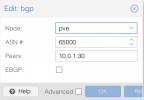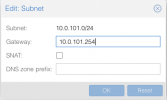I try to setup the following:
3 Node Proxmox Cluster using EVPN between nodes. This works as expected.
Now I want to uplink the EVPN to a Fortigate via BGP for uplink.
I have added a BGP Controller to a node and set this node as exit node.
Routes are correctly advertised.
But traffic sent from a lxc container is leaving on the wrong interface and not sent to the correct gateway:
PCAP:
10:32:49.632523 veth124i0 P IP 10.182.3.100 > one.one.one.one: ICMP echo request, id 57889, seq 6, length 64
10:32:49.632530 fwln124i0 Out IP 10.182.3.100 > one.one.one.one: ICMP echo request, id 57889, seq 6, length 64
10:32:49.632531 fwpr124p0 P IP 10.182.3.100 > one.one.one.one: ICMP echo request, id 57889, seq 6, length 64
10:32:49.632531 evpn01 In IP 10.182.3.100 > one.one.one.one: ICMP echo request, id 57889, seq 6, length 64
10:32:49.632545 vmbr0_182 Out IP 10.182.3.100 > one.one.one.one: ICMP echo request, id 57889, seq 6, length 64
10:32:49.632551 eno2 Out IP 10.182.3.100 > one.one.one.one: ICMP echo request, id 57889, seq 6, length 64
As you can see traffic is sent out via vmbr0_182, vmbr0_182 is the interface with the default gateway, but traffic should be sent to the IP 100.111.64.1, which is directly connected on vmbr0_164
IP Route:
default via 10.182.2.1 dev vmbr0_182 proto kernel onlink
default nhid 149 via 100.111.64.1 dev vmbr0_164 proto bgp metric 20
10.42.1.0/24 nhid 149 via 100.111.64.1 dev vmbr0_164 proto bgp metric 20
10.42.42.0/24 nhid 149 via 100.111.64.1 dev vmbr0_164 proto bgp metric 20
10.42.55.0/24 nhid 149 via 100.111.64.1 dev vmbr0_164 proto bgp metric 20
10.182.0.0/24 nhid 150 via 100.111.64.2 dev vmbr0_164 proto bgp metric 20
10.182.1.0/24 nhid 150 via 100.111.64.2 dev vmbr0_164 proto bgp metric 20
10.182.2.0/24 dev vmbr0_182 proto kernel scope link src 10.182.2.101
10.212.134.254/31 nhid 149 via 100.111.64.1 dev vmbr0_164 proto bgp metric 20
100.111.64.0/29 dev vmbr0_164 proto kernel scope link src 100.111.64.3
100.111.64.10/31 nhid 149 via 100.111.64.1 dev vmbr0_164 proto bgp metric 20
100.111.64.12/31 nhid 149 via 100.111.64.1 dev vmbr0_164 proto bgp metric 20
151.248.130.0/24 nhid 149 via 100.111.64.1 dev vmbr0_164 proto bgp metric 20
192.168.101.0/24 dev vmbr1_101 proto kernel scope link src 192.168.101.101
192.168.102.0/24 dev vmbr1_102 proto kernel scope link src 192.168.102.101
FRR routing table:
root@chsfl1-cl01-pve01:~# vtysh -c "sh ip route"
B>* 0.0.0.0/0 [20/0] via 100.111.64.1, vmbr0_164, weight 1, 00:49:13
B>* 10.42.1.0/24 [20/0] via 100.111.64.1, vmbr0_164, weight 1, 00:59:57
B>* 10.42.42.0/24 [20/10] via 100.111.64.1, vmbr0_164, weight 1, 00:59:57
B>* 10.42.55.0/24 [20/10] via 100.111.64.1, vmbr0_164, weight 1, 00:59:57
B>* 10.182.0.0/24 [20/0] via 100.111.64.2, vmbr0_164, weight 1, 00:59:57
B>* 10.182.1.0/24 [20/0] via 100.111.64.2, vmbr0_164, weight 1, 00:59:57
B 10.182.2.0/24 [20/0] via 100.111.64.1, vmbr0_164, weight 1, 00:59:57
C>* 10.182.2.0/24 is directly connected, vmbr0_182, 1d14h32m
B>* 10.182.3.0/24 [20/0] is directly connected, evpn01 (vrf vrf_evpn), weight 1, 00:49:14
B>* 10.212.134.254/31 [20/0] via 100.111.64.1, vmbr0_164, weight 1, 00:59:57
B 100.111.64.0/29 [20/0] via 100.111.64.1 inactive, weight 1, 00:59:57
C>* 100.111.64.0/29 is directly connected, vmbr0_164, 1d14h31m
B>* 100.111.64.10/31 [20/0] via 100.111.64.1, vmbr0_164, weight 1, 00:59:57
B>* 100.111.64.12/31 [20/0] via 100.111.64.1, vmbr0_164, weight 1, 00:59:57
B>* 151.248.130.0/24 [20/0] via 100.111.64.1, vmbr0_164, weight 1, 00:59:57
C>* 192.168.101.0/24 is directly connected, vmbr1_101, 1d14h32m
C>* 192.168.102.0/24 is directly connected, vmbr1_102, 1d14h32m
How can I get the SDN to send traffic to the gateway received by FRR via BGP instead of to the default gateway of the PVE host?






